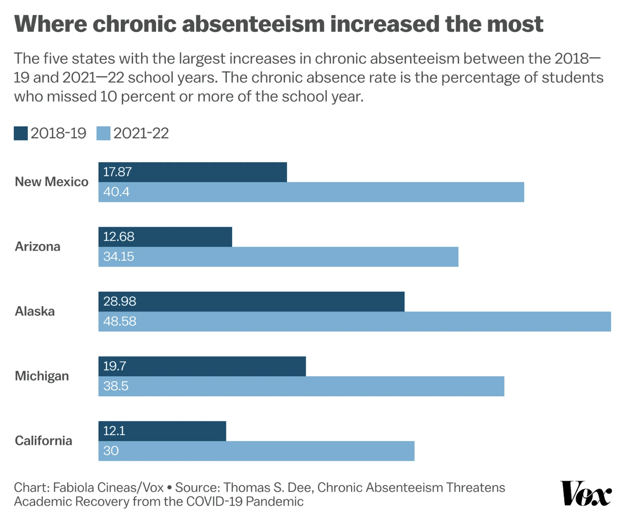Schools across the country are grappling with fewer students in classrooms, causing a ripple effect on learning, funding, and engagement. Research shows that the number of chronically absent students has nearly doubled, from about 15 percent in the 2018-2019 school year to around 30 percent in 2021-2022. Millions of students miss 10% of the school year or more—whether excused or unexcused—and substantial increases in chronic absenteeism were prevalent across every state that captures this data. The research results imply that an additional 6.5 million students became chronically absent in the ‘21-’22 school year, on top of the millions of students who were chronically absent before the pandemic. Because of the correlation between attendance and learning, this uptick in absenteeism has grave consequences for student growth. In states like Texas, where school funding is tied to attendance, it also creates financial constraints.

At Education Elements, we help schools and districts solve their biggest problems. In recent years, that means our work has included strategic planning, return planning in the wake of COVID-19, addressing declining enrollment, developing new school models, coaching leaders, and implementing high quality instructional materials in personalized ways. Right now, chronic absenteeism is a nationwide problem that’s bigger than ever, and we need to start thinking more strategically about how to solve it.
If you’ve been around our blog for awhile, you know we often talk about prioritization. Schools and districts face lots of challenges; part of our work is knowing which ones to invest in finding solutions. The rate at which chronic absenteeism is increasing, and the detrimental effects it has on student academic learning (not to mention, school culture, school funding, student wellness) mean this challenge is one that needs immediate attention. To start, we need to ask:
- Where are the students? Is a rise in chronic absenteeism due to barriers, a lack of joy/belonging at school, disengagement with the learning, poor communication around attendance—or something else entirely?
- Who are the outliers? Where is attendance increasing, despite geographical dips, and what of their work is transferable?
- How might we propose systematic ways to address chronic absenteeism with research backed strategies, while also honoring the regional nuances of each individual district?
- How do we brace for impact— redistributing district resources to respond to chronic absenteeism today—while simultaneously implementing adjustments to lead to greater attendance in the future?
For many districts right now, they’re forced to do more with less: to receive less funding than before, but also implement instructional practices backed by recent policy and research shifts, navigate school closures and reduction in staffing, and also work to move enrollment back to its target state. To also address the “hidden educational crisis” of absenteeism may feel like too much. But we often say, “All organizations are perfectly designed to get the results they are now getting. If we want different results, we must change the way we do things.”
Right now, school systems are perfectly designed for millions of students to miss out on learning. We need to change the way we do things. Over the next few weeks, we’ll be addressing chronic absenteeism in a series of blogs and webinars, starting with today—acknowledging the problem at hand. On March 7th, we’ll share strategies for responsive leadership to adjust how your systems approach chronic absenteeism. We’ll look at school models and ways to increase belonging and engagement in schools, explore outliers and stories of success, and discuss how to make schools a happier place for students. No issue as complex as this has a one-size-fits-all solution, but we hope the ideas and strategies we share can help your team get started. As always, let us know if we can help you work through your challenges one on one.
